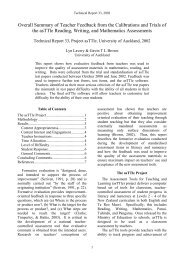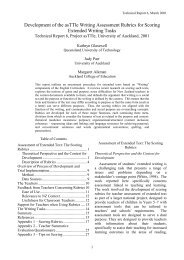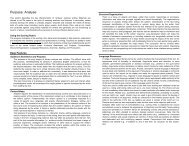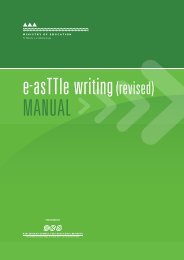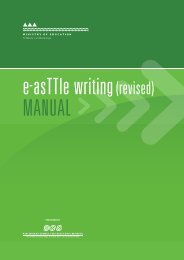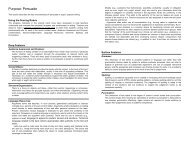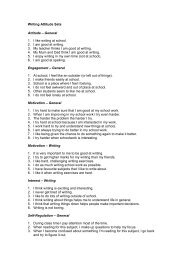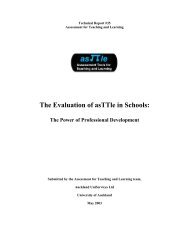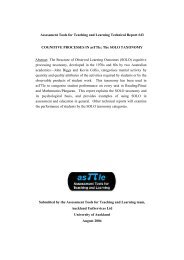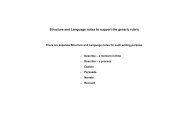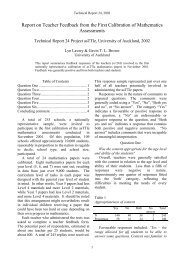11. Maths in the NZ curriculum 2001.pdf - e-asTTle - Te Kete Ipurangi
11. Maths in the NZ curriculum 2001.pdf - e-asTTle - Te Kete Ipurangi
11. Maths in the NZ curriculum 2001.pdf - e-asTTle - Te Kete Ipurangi
Create successful ePaper yourself
Turn your PDF publications into a flip-book with our unique Google optimized e-Paper software.
<strong>Te</strong>chnical Report 11: Mapp<strong>in</strong>g <strong>the</strong> Ma<strong>the</strong>matics Curriculum 7<br />
clustered here as th<strong>in</strong>gs that children should<br />
know at given levels.<br />
Read/follow<br />
Children are required to be able to <strong>in</strong>terpret<br />
and read as well as to produce ma<strong>the</strong>matics.<br />
These objectives ask children to receive<br />
ma<strong>the</strong>matical <strong>in</strong>formation by read<strong>in</strong>g or<br />
follow<strong>in</strong>g directions.<br />
Solve<br />
This category highlights <strong>the</strong> <strong>curriculum</strong>’s<br />
emphasis on problem solv<strong>in</strong>g. Children are<br />
asked to solve problems across <strong>the</strong> content<br />
strands, and this cluster shows how <strong>the</strong>se<br />
objectives are all related to problem solv<strong>in</strong>g<br />
processes.<br />
Discussion<br />
This report presents two concept maps of <strong>the</strong><br />
Mi<strong>NZ</strong>C objectives at Levels 2, 3, and 4. The<br />
maps each highlight different aspects of <strong>the</strong><br />
document. Three key areas for discussion arise<br />
from this: teach<strong>in</strong>g issues, organisation of <strong>the</strong><br />
objectives, and <strong>the</strong> development of<br />
ma<strong>the</strong>matical concepts.<br />
The document directs how ma<strong>the</strong>matics<br />
should be taught, as well as provid<strong>in</strong>g <strong>the</strong><br />
ma<strong>the</strong>matics content to be taught. <strong>Te</strong>ach<strong>in</strong>g<br />
issues arise from this. Objectives <strong>in</strong> <strong>the</strong> Mi<strong>NZ</strong>C<br />
document are written and organised <strong>in</strong> certa<strong>in</strong><br />
ways, which affects both how <strong>the</strong> concepts are<br />
taught and how <strong>the</strong>y are assessed. F<strong>in</strong>ally,<br />
Mi<strong>NZ</strong>C attempts to organise children’s<br />
cognitive development <strong>in</strong>to a framework for<br />
teach<strong>in</strong>g. This has important implications for<br />
teachers and learners. These issues are<br />
discussed below.<br />
Issues for <strong>Te</strong>ach<strong>in</strong>g from Mi<strong>NZ</strong>C<br />
General <strong>the</strong>mes of <strong>the</strong> Mi<strong>NZ</strong>C document.<br />
Several general <strong>the</strong>mes underlie all <strong>the</strong><br />
achievement objectives <strong>in</strong> <strong>the</strong> <strong>curriculum</strong><br />
document. These are featured <strong>in</strong> <strong>the</strong><br />
<strong>in</strong>troduction to <strong>the</strong> <strong>curriculum</strong>. Ma<strong>the</strong>matics is<br />
seen as vital to effective participation <strong>in</strong> society<br />
and work. It should be relevant to children and<br />
<strong>the</strong>refore must be presented <strong>in</strong> realistic contexts.<br />
Ma<strong>the</strong>matical tasks should encourage children<br />
to act like ma<strong>the</strong>maticians – us<strong>in</strong>g conjecture<br />
and strategy to solve problems. Activities<br />
should <strong>the</strong>refore encourage th<strong>in</strong>k<strong>in</strong>g and <strong>the</strong> use<br />
of problem-solv<strong>in</strong>g processes. The best<br />
activities will cover several objectives, and will<br />
be ma<strong>the</strong>matically rich as well as<br />
ma<strong>the</strong>matically au<strong>the</strong>ntic.<br />
Establish<strong>in</strong>g ma<strong>the</strong>matical concepts will<br />
<strong>in</strong>volve <strong>the</strong> use of appropriate equipment and<br />
active manipulation by children. Confidence <strong>in</strong><br />
and enjoyment of ma<strong>the</strong>matics will be<br />
promoted.<br />
New material at earlier levels. Ma<strong>the</strong>matics<br />
<strong>in</strong> <strong>the</strong> New Zealand Curriculum (Mi<strong>NZ</strong>C)<br />
(M<strong>in</strong>istry of Education, 1993a) <strong>in</strong>troduced some<br />
concepts at earlier stages of school<strong>in</strong>g than<br />
previous curricula had done. Algebra and<br />
statistics <strong>in</strong> particular were now required from<br />
<strong>the</strong> beg<strong>in</strong>n<strong>in</strong>g of school<strong>in</strong>g. The development<br />
of understand<strong>in</strong>g <strong>in</strong> <strong>the</strong>se strands, while it tends<br />
to appear clearly def<strong>in</strong>ed, may not reflect <strong>the</strong><br />
ways <strong>in</strong> which children learn <strong>in</strong> <strong>the</strong>se areas. An<br />
example of this is <strong>the</strong> probability objectives,<br />
which appear to be <strong>in</strong> a clear, logical sequence.<br />
However, Nickson (2000) found that <strong>the</strong><br />
possible contributions of both developmental<br />
stages and children’s <strong>in</strong>tuition to understand<strong>in</strong>g<br />
probability needed to be considered <strong>in</strong><br />
determ<strong>in</strong><strong>in</strong>g <strong>the</strong> sequence of probability<br />
objectives. Underly<strong>in</strong>g cognitive structures and<br />
strategies <strong>in</strong> primary-age children are less well<br />
understood <strong>in</strong> content strands such as statistics<br />
than <strong>in</strong> <strong>the</strong> area of numeracy.<br />
Ma<strong>the</strong>matical processes strand. The sixth<br />
strand of Mi<strong>NZ</strong>C covers ma<strong>the</strong>matical<br />
processes, which has a different structure from<br />
<strong>the</strong> content strands. Ma<strong>the</strong>matical processes<br />
<strong>in</strong>cludes three sub-strands (problem solv<strong>in</strong>g,<br />
communicat<strong>in</strong>g ma<strong>the</strong>matical ideas, and logic<br />
and reason<strong>in</strong>g), and objectives are listed for<br />
each of <strong>the</strong>se. Some objectives are <strong>in</strong>troduced<br />
at later levels, while o<strong>the</strong>rs are <strong>the</strong> same for all<br />
levels.<br />
The strand attempts to def<strong>in</strong>e <strong>the</strong> skills of<br />
work<strong>in</strong>g ma<strong>the</strong>matically that should be taught<br />
across <strong>the</strong> content strands. The objectives<br />
necessarily represent a selection of <strong>the</strong> skills<br />
required to “do ma<strong>the</strong>matics”, and <strong>the</strong>y have<br />
been assigned to levels by <strong>the</strong> <strong>curriculum</strong>





